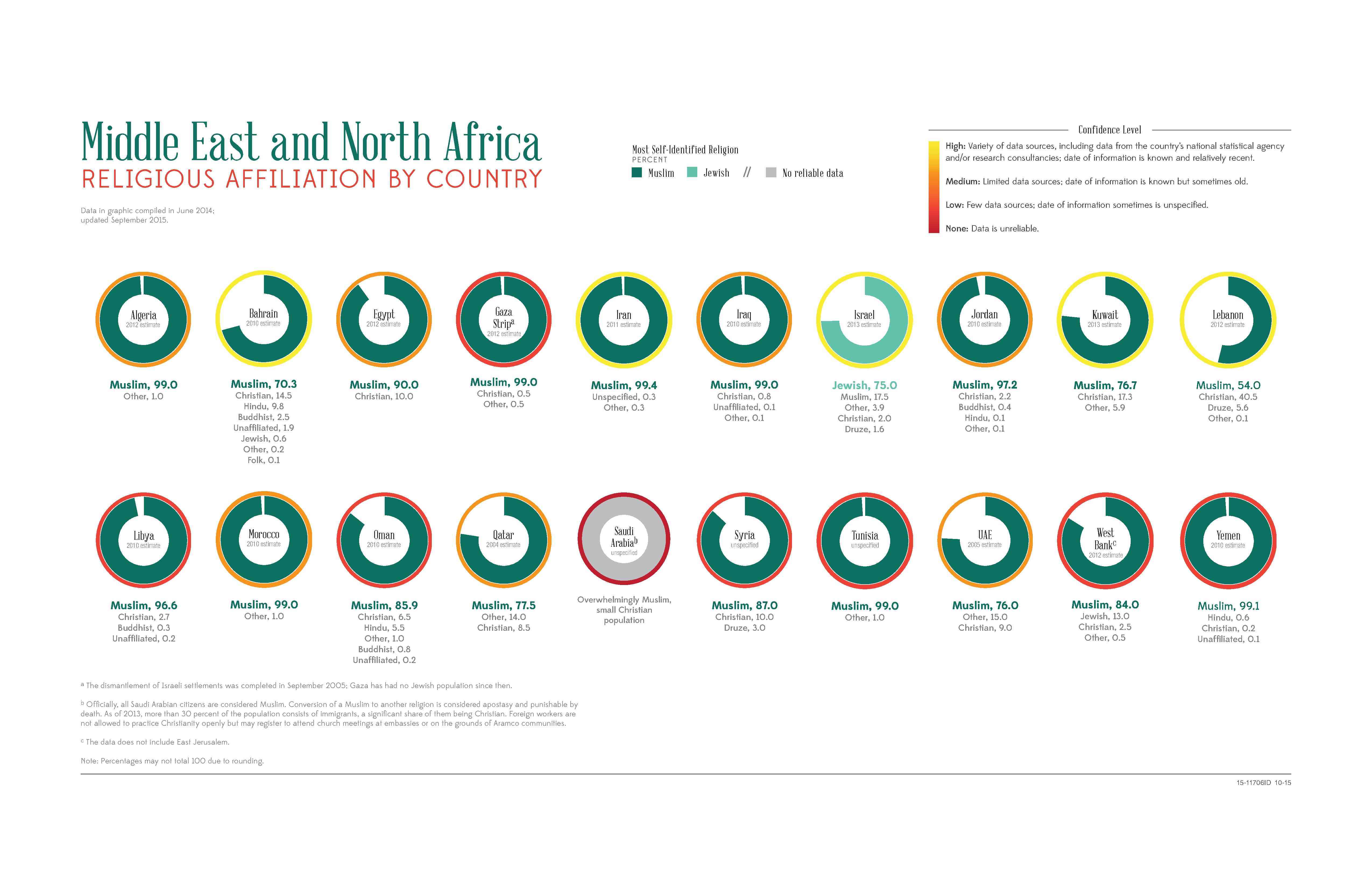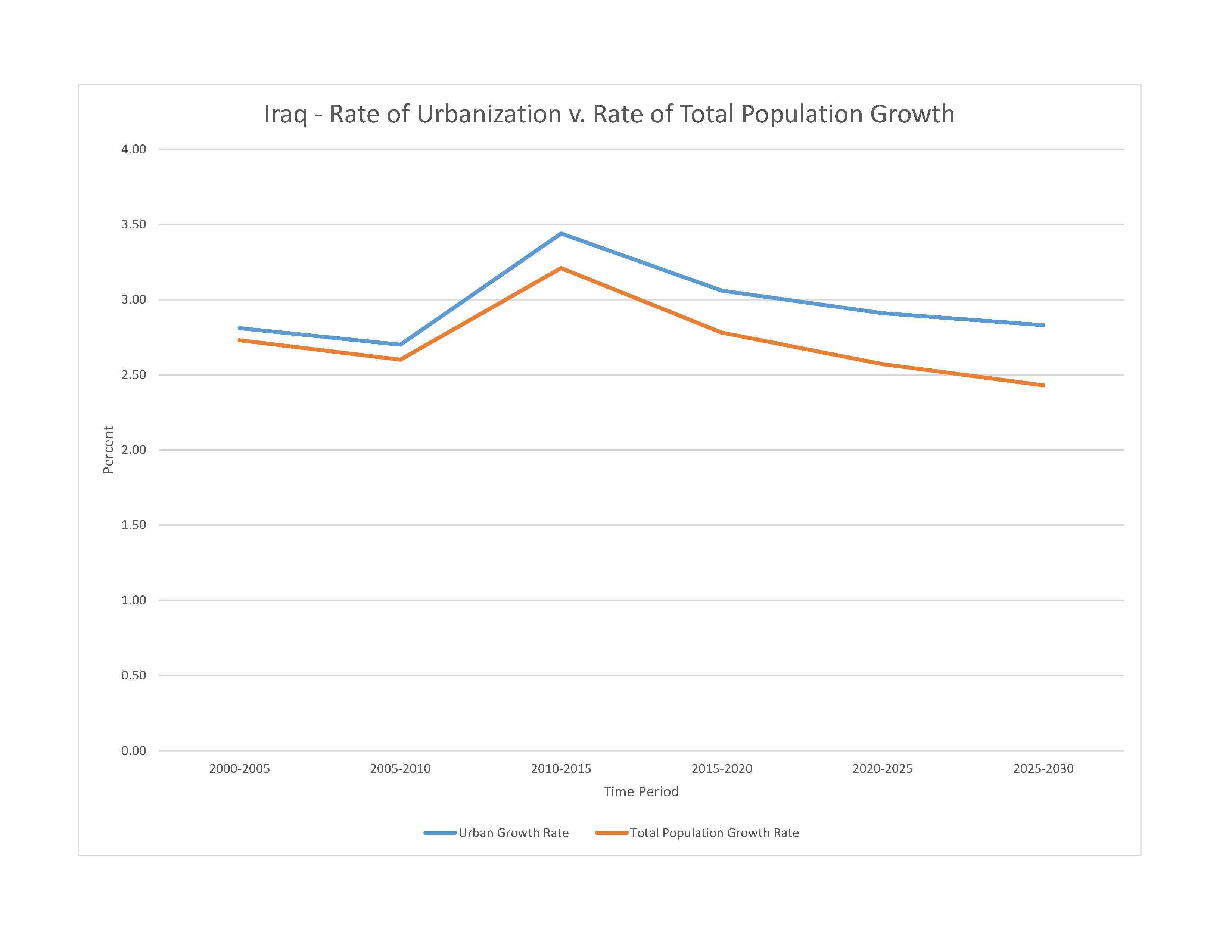
41,266,109 (2023 est.)
noun: Iraqi(s)
adjective: Iraqi
Arab 75-80%, Kurdish 15-20%, other 5% (includes Turkmen, Yezidi, Shabak, Kaka'i, Bedouin, Romani, Assyrian, Circassian, Sabaean-Mandaean, Persian)
note: data is a 1987 government estimate; no more recent reliable numbers are available
Arabic (official), Kurdish (official); Turkmen (a Turkish dialect) and Syriac (Neo-Aramaic) are recognized as official languages where native speakers of these languages are present; Iraqis have the right to be educated in their native language
major-language sample(s):
كتاب حقائق العالم، أحسن مصدر للمعلومات الأساسية (Arabic)
ڕاستییەکانی جیهان، باشترین سەرچاوەیە بۆ زانیارییە بنەڕەتییەکان (Kurdish)
The World Factbook, the indispensable source for basic information.
Arabic audio sample:
Kurdish audio sample:
Muslim (official) 95-98% (Shia 61-64%, Sunni 29-34%), Christian 1% (includes Catholic, Orthodox, Protestant, Assyrian Church of the East), other 1-4% (2015 est.)
note: the last census in Iraq was in 1997; while there has been voluntary relocation of many Christian families to northern Iraq, the overall Christian population has decreased at least 50% and perhaps as much as 90% since 2003, according to US Embassy estimates, with many fleeing to Syria, Jordan, and Lebanon

0-14 years: 35.24% (male 7,428,445/female 7,113,723)
15-64 years: 61.17% (male 12,692,897/female 12,548,936)
65 years and over: 3.59% (2023 est.) (male 658,844/female 823,264)
total dependency ratio: 71
youth dependency ratio: 65.2
elderly dependency ratio: 5.8
potential support ratio: 17.1 (2021 est.)
total: 22.1 years (2023 est.)
male: 21.7 years
female: 22.4 years
1.94% (2023 est.)
24.2 births/1,000 population (2023 est.)
3.9 deaths/1,000 population (2023 est.)
-1 migrant(s)/1,000 population (2023 est.)
population is concentrated in the north, center, and eastern parts of the country, with many of the larger urban agglomerations found along extensive parts of the Tigris and Euphrates Rivers; much of the western and southern areas are either lightly populated or uninhabited
urban population: 71.6% of total population (2023)
rate of urbanization: 2.91% annual rate of change (2020-25 est.)

7.711 million BAGHDAD (capital), 1.792 million Mosul, 1.448 million Basra, 1.075 million Kirkuk, 958,000 Najaf, 897,000 Erbil (2023)
at birth: 1.05 male(s)/female
0-14 years: 1.04 male(s)/female
15-64 years: 1.01 male(s)/female
65 years and over: 0.8 male(s)/female
total population: 1.01 male(s)/female (2023 est.)
76 deaths/100,000 live births (2020 est.)
total: 19.2 deaths/1,000 live births (2023 est.)
male: 20.9 deaths/1,000 live births
female: 17.4 deaths/1,000 live births
total population: 73.5 years (2023 est.)
male: 71.6 years
female: 75.4 years
3.17 children born/woman (2023 est.)
1.55 (2023 est.)
52.8% (2018)
improved: urban: 100% of population
rural: 97.4% of population
total: 99.3% of population
unimproved: urban: 0% of population
rural: 2.6% of population
total: 0.7% of population (2020 est.)
5.1% of GDP (2020)
0.97 physicians/1,000 population (2020)
1.3 beds/1,000 population (2017)
improved: urban: 100% of population
rural: 100% of population
total: 100% of population
unimproved: urban: 0% of population
rural: 0% of population
total: 0% of population (2020 est.)
degree of risk: intermediate (2023)
food or waterborne diseases: bacterial diarrhea, hepatitis A, and typhoid fever
30.4% (2016)
total: 0.16 liters of pure alcohol (2019 est.)
beer: 0.11 liters of pure alcohol (2019 est.)
wine: 0 liters of pure alcohol (2019 est.)
spirits: 0.04 liters of pure alcohol (2019 est.)
other alcohols: 0 liters of pure alcohol (2019 est.)
total: 18.5% (2020 est.)
male: 35.1% (2020 est.)
female: 1.8% (2020 est.)
3.9% (2018)
65.5% (2023 est.)
women married by age 15: 7.2%
women married by age 18: 27.9% (2018 est.)
4.7% of GDP (2016)
definition: age 15 and over can read and write
total population: 85.6%
male: 91.2%
female: 79.9% (2017)
NOTE: The information regarding Iraq on this page is re-published from the 2024 World Fact Book of the United States Central Intelligence Agency and other sources. No claims are made regarding the accuracy of Iraq 2024 information contained here. All suggestions for corrections of any errors about Iraq 2024 should be addressed to the CIA or the source cited on each page.
This page was last modified 04 May 24, Copyright © 2024 ITA all rights reserved.